Applied Corporate Strategy Analysis: Sainsbury's and Asda Merger
VerifiedAdded on 2023/01/19
|16
|5062
|97
Report
AI Summary
This report offers a comprehensive analysis of Sainsbury's corporate strategy, focusing on the potential merger with Asda. It begins with an introduction to corporate strategy and its importance, followed by an external analysis employing the PESTLE framework to assess political, economic, social, technological, legal, and environmental factors impacting Sainsbury's operations, particularly in the context of Brexit. Porter's Five Forces model is then applied to evaluate the industry's attractiveness. The report proceeds with an internal analysis, utilizing TOWS and VRIO analyses to identify the company's strengths, weaknesses, opportunities, threats, and core competencies. Finally, the SAF (Suitability, Acceptability, Feasibility) criteria are applied to evaluate the merger strategy. The report concludes with a summary of findings and recommendations, providing a detailed overview of Sainsbury's strategic position and the implications of the proposed merger.
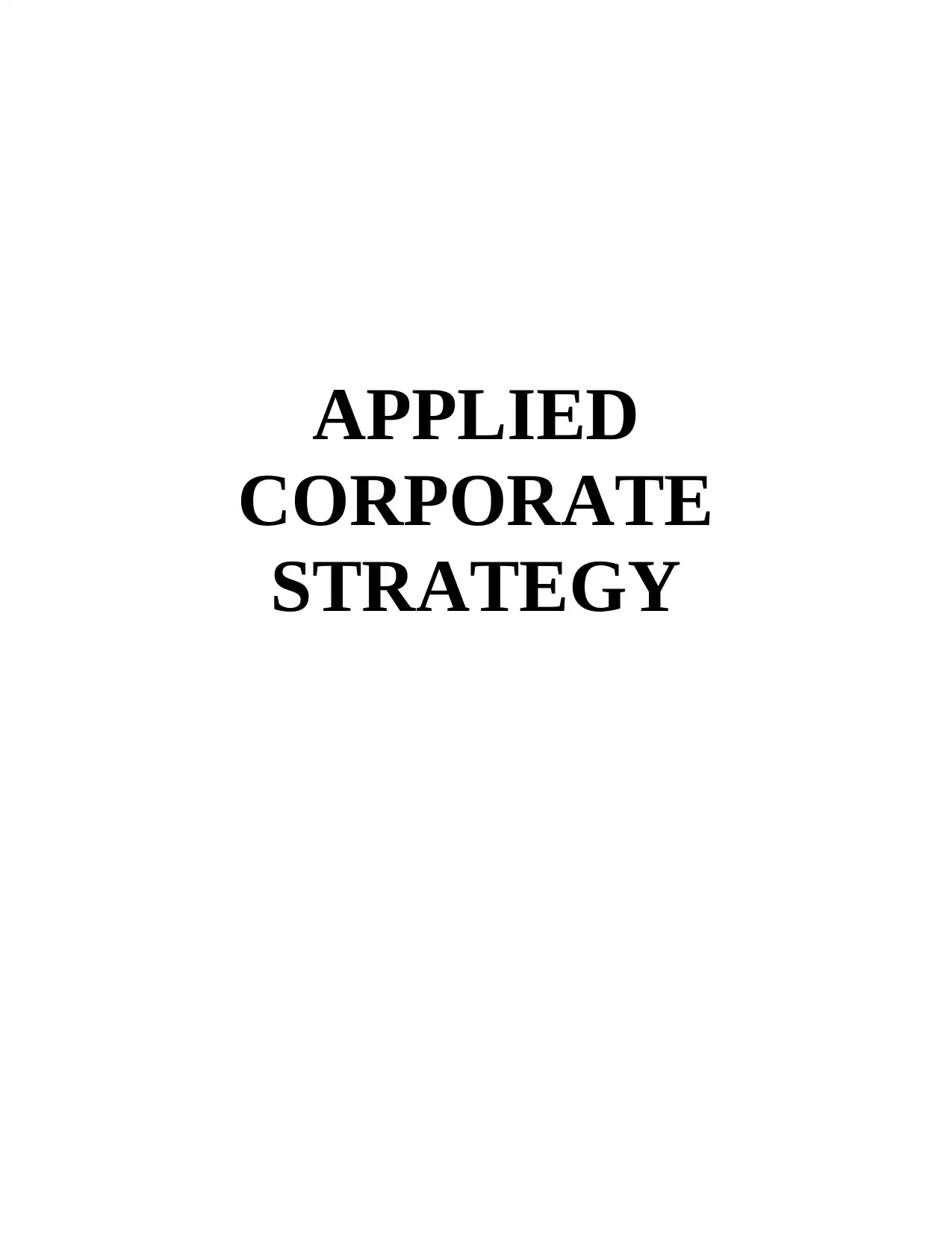
APPLIED
CORPORATE
STRATEGY
CORPORATE
STRATEGY
Paraphrase This Document
Need a fresh take? Get an instant paraphrase of this document with our AI Paraphraser
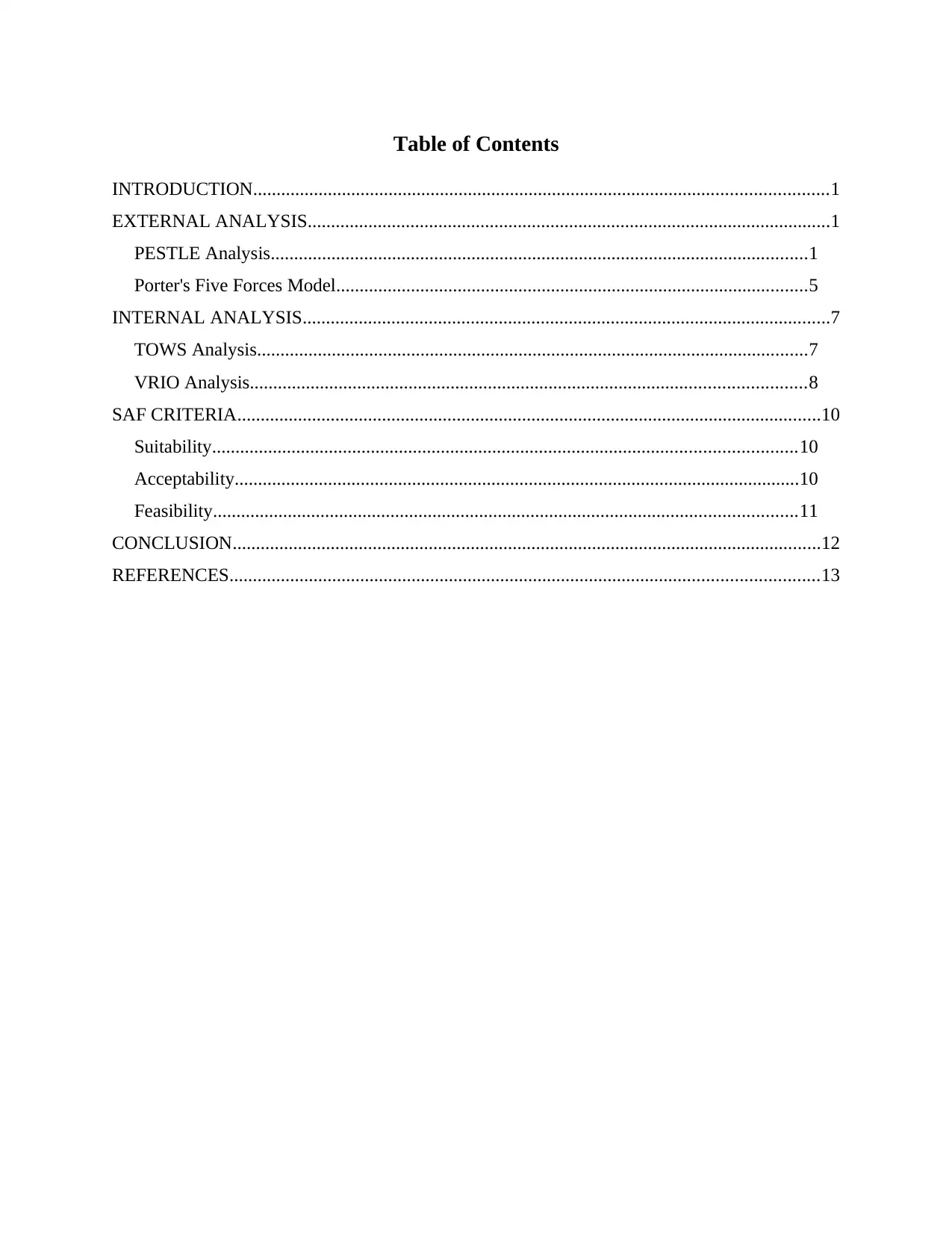
Table of Contents
INTRODUCTION...........................................................................................................................1
EXTERNAL ANALYSIS................................................................................................................1
PESTLE Analysis...................................................................................................................1
Porter's Five Forces Model.....................................................................................................5
INTERNAL ANALYSIS.................................................................................................................7
TOWS Analysis......................................................................................................................7
VRIO Analysis.......................................................................................................................8
SAF CRITERIA.............................................................................................................................10
Suitability.............................................................................................................................10
Acceptability.........................................................................................................................10
Feasibility.............................................................................................................................11
CONCLUSION..............................................................................................................................12
REFERENCES..............................................................................................................................13
INTRODUCTION...........................................................................................................................1
EXTERNAL ANALYSIS................................................................................................................1
PESTLE Analysis...................................................................................................................1
Porter's Five Forces Model.....................................................................................................5
INTERNAL ANALYSIS.................................................................................................................7
TOWS Analysis......................................................................................................................7
VRIO Analysis.......................................................................................................................8
SAF CRITERIA.............................................................................................................................10
Suitability.............................................................................................................................10
Acceptability.........................................................................................................................10
Feasibility.............................................................................................................................11
CONCLUSION..............................................................................................................................12
REFERENCES..............................................................................................................................13
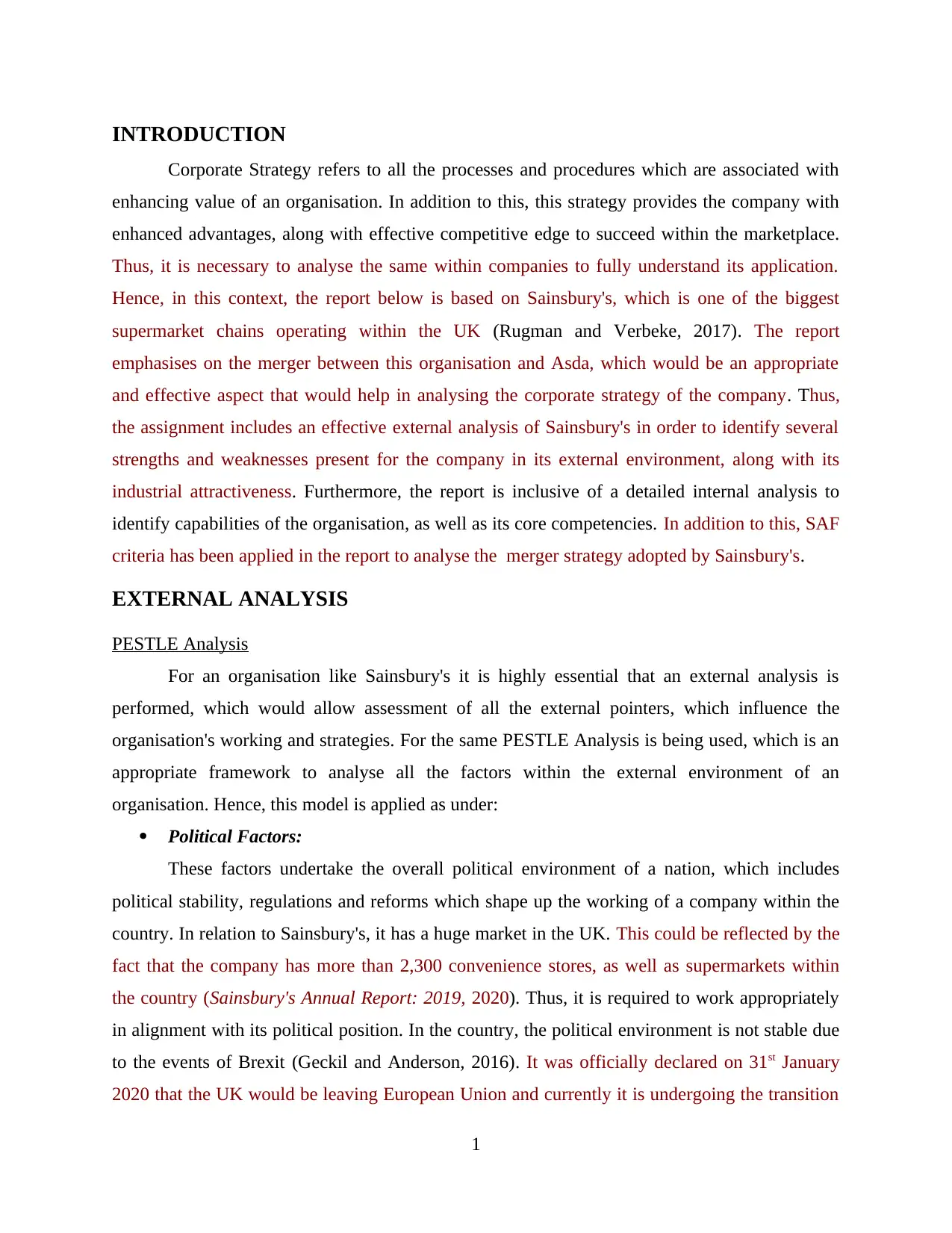
INTRODUCTION
Corporate Strategy refers to all the processes and procedures which are associated with
enhancing value of an organisation. In addition to this, this strategy provides the company with
enhanced advantages, along with effective competitive edge to succeed within the marketplace.
Thus, it is necessary to analyse the same within companies to fully understand its application.
Hence, in this context, the report below is based on Sainsbury's, which is one of the biggest
supermarket chains operating within the UK (Rugman and Verbeke, 2017). The report
emphasises on the merger between this organisation and Asda, which would be an appropriate
and effective aspect that would help in analysing the corporate strategy of the company. Thus,
the assignment includes an effective external analysis of Sainsbury's in order to identify several
strengths and weaknesses present for the company in its external environment, along with its
industrial attractiveness. Furthermore, the report is inclusive of a detailed internal analysis to
identify capabilities of the organisation, as well as its core competencies. In addition to this, SAF
criteria has been applied in the report to analyse the merger strategy adopted by Sainsbury's.
EXTERNAL ANALYSIS
PESTLE Analysis
For an organisation like Sainsbury's it is highly essential that an external analysis is
performed, which would allow assessment of all the external pointers, which influence the
organisation's working and strategies. For the same PESTLE Analysis is being used, which is an
appropriate framework to analyse all the factors within the external environment of an
organisation. Hence, this model is applied as under:
Political Factors:
These factors undertake the overall political environment of a nation, which includes
political stability, regulations and reforms which shape up the working of a company within the
country. In relation to Sainsbury's, it has a huge market in the UK. This could be reflected by the
fact that the company has more than 2,300 convenience stores, as well as supermarkets within
the country (Sainsbury's Annual Report: 2019, 2020). Thus, it is required to work appropriately
in alignment with its political position. In the country, the political environment is not stable due
to the events of Brexit (Geckil and Anderson, 2016). It was officially declared on 31st January
2020 that the UK would be leaving European Union and currently it is undergoing the transition
1
Corporate Strategy refers to all the processes and procedures which are associated with
enhancing value of an organisation. In addition to this, this strategy provides the company with
enhanced advantages, along with effective competitive edge to succeed within the marketplace.
Thus, it is necessary to analyse the same within companies to fully understand its application.
Hence, in this context, the report below is based on Sainsbury's, which is one of the biggest
supermarket chains operating within the UK (Rugman and Verbeke, 2017). The report
emphasises on the merger between this organisation and Asda, which would be an appropriate
and effective aspect that would help in analysing the corporate strategy of the company. Thus,
the assignment includes an effective external analysis of Sainsbury's in order to identify several
strengths and weaknesses present for the company in its external environment, along with its
industrial attractiveness. Furthermore, the report is inclusive of a detailed internal analysis to
identify capabilities of the organisation, as well as its core competencies. In addition to this, SAF
criteria has been applied in the report to analyse the merger strategy adopted by Sainsbury's.
EXTERNAL ANALYSIS
PESTLE Analysis
For an organisation like Sainsbury's it is highly essential that an external analysis is
performed, which would allow assessment of all the external pointers, which influence the
organisation's working and strategies. For the same PESTLE Analysis is being used, which is an
appropriate framework to analyse all the factors within the external environment of an
organisation. Hence, this model is applied as under:
Political Factors:
These factors undertake the overall political environment of a nation, which includes
political stability, regulations and reforms which shape up the working of a company within the
country. In relation to Sainsbury's, it has a huge market in the UK. This could be reflected by the
fact that the company has more than 2,300 convenience stores, as well as supermarkets within
the country (Sainsbury's Annual Report: 2019, 2020). Thus, it is required to work appropriately
in alignment with its political position. In the country, the political environment is not stable due
to the events of Brexit (Geckil and Anderson, 2016). It was officially declared on 31st January
2020 that the UK would be leaving European Union and currently it is undergoing the transition
1
⊘ This is a preview!⊘
Do you want full access?
Subscribe today to unlock all pages.

Trusted by 1+ million students worldwide
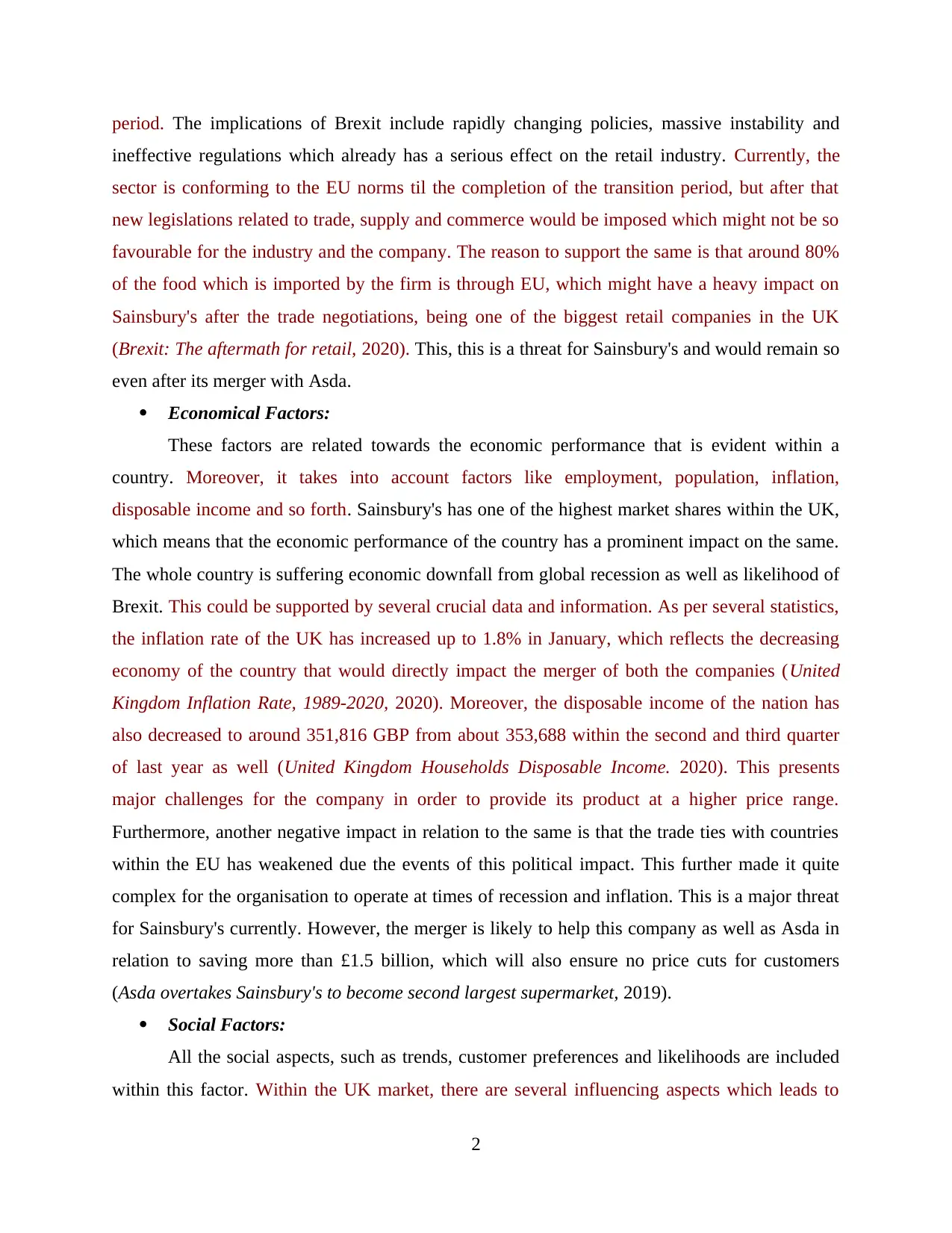
period. The implications of Brexit include rapidly changing policies, massive instability and
ineffective regulations which already has a serious effect on the retail industry. Currently, the
sector is conforming to the EU norms til the completion of the transition period, but after that
new legislations related to trade, supply and commerce would be imposed which might not be so
favourable for the industry and the company. The reason to support the same is that around 80%
of the food which is imported by the firm is through EU, which might have a heavy impact on
Sainsbury's after the trade negotiations, being one of the biggest retail companies in the UK
(Brexit: The aftermath for retail, 2020). This, this is a threat for Sainsbury's and would remain so
even after its merger with Asda.
Economical Factors:
These factors are related towards the economic performance that is evident within a
country. Moreover, it takes into account factors like employment, population, inflation,
disposable income and so forth. Sainsbury's has one of the highest market shares within the UK,
which means that the economic performance of the country has a prominent impact on the same.
The whole country is suffering economic downfall from global recession as well as likelihood of
Brexit. This could be supported by several crucial data and information. As per several statistics,
the inflation rate of the UK has increased up to 1.8% in January, which reflects the decreasing
economy of the country that would directly impact the merger of both the companies (United
Kingdom Inflation Rate, 1989-2020, 2020). Moreover, the disposable income of the nation has
also decreased to around 351,816 GBP from about 353,688 within the second and third quarter
of last year as well (United Kingdom Households Disposable Income. 2020). This presents
major challenges for the company in order to provide its product at a higher price range.
Furthermore, another negative impact in relation to the same is that the trade ties with countries
within the EU has weakened due the events of this political impact. This further made it quite
complex for the organisation to operate at times of recession and inflation. This is a major threat
for Sainsbury's currently. However, the merger is likely to help this company as well as Asda in
relation to saving more than £1.5 billion, which will also ensure no price cuts for customers
(Asda overtakes Sainsbury's to become second largest supermarket, 2019).
Social Factors:
All the social aspects, such as trends, customer preferences and likelihoods are included
within this factor. Within the UK market, there are several influencing aspects which leads to
2
ineffective regulations which already has a serious effect on the retail industry. Currently, the
sector is conforming to the EU norms til the completion of the transition period, but after that
new legislations related to trade, supply and commerce would be imposed which might not be so
favourable for the industry and the company. The reason to support the same is that around 80%
of the food which is imported by the firm is through EU, which might have a heavy impact on
Sainsbury's after the trade negotiations, being one of the biggest retail companies in the UK
(Brexit: The aftermath for retail, 2020). This, this is a threat for Sainsbury's and would remain so
even after its merger with Asda.
Economical Factors:
These factors are related towards the economic performance that is evident within a
country. Moreover, it takes into account factors like employment, population, inflation,
disposable income and so forth. Sainsbury's has one of the highest market shares within the UK,
which means that the economic performance of the country has a prominent impact on the same.
The whole country is suffering economic downfall from global recession as well as likelihood of
Brexit. This could be supported by several crucial data and information. As per several statistics,
the inflation rate of the UK has increased up to 1.8% in January, which reflects the decreasing
economy of the country that would directly impact the merger of both the companies (United
Kingdom Inflation Rate, 1989-2020, 2020). Moreover, the disposable income of the nation has
also decreased to around 351,816 GBP from about 353,688 within the second and third quarter
of last year as well (United Kingdom Households Disposable Income. 2020). This presents
major challenges for the company in order to provide its product at a higher price range.
Furthermore, another negative impact in relation to the same is that the trade ties with countries
within the EU has weakened due the events of this political impact. This further made it quite
complex for the organisation to operate at times of recession and inflation. This is a major threat
for Sainsbury's currently. However, the merger is likely to help this company as well as Asda in
relation to saving more than £1.5 billion, which will also ensure no price cuts for customers
(Asda overtakes Sainsbury's to become second largest supermarket, 2019).
Social Factors:
All the social aspects, such as trends, customer preferences and likelihoods are included
within this factor. Within the UK market, there are several influencing aspects which leads to
2
Paraphrase This Document
Need a fresh take? Get an instant paraphrase of this document with our AI Paraphraser
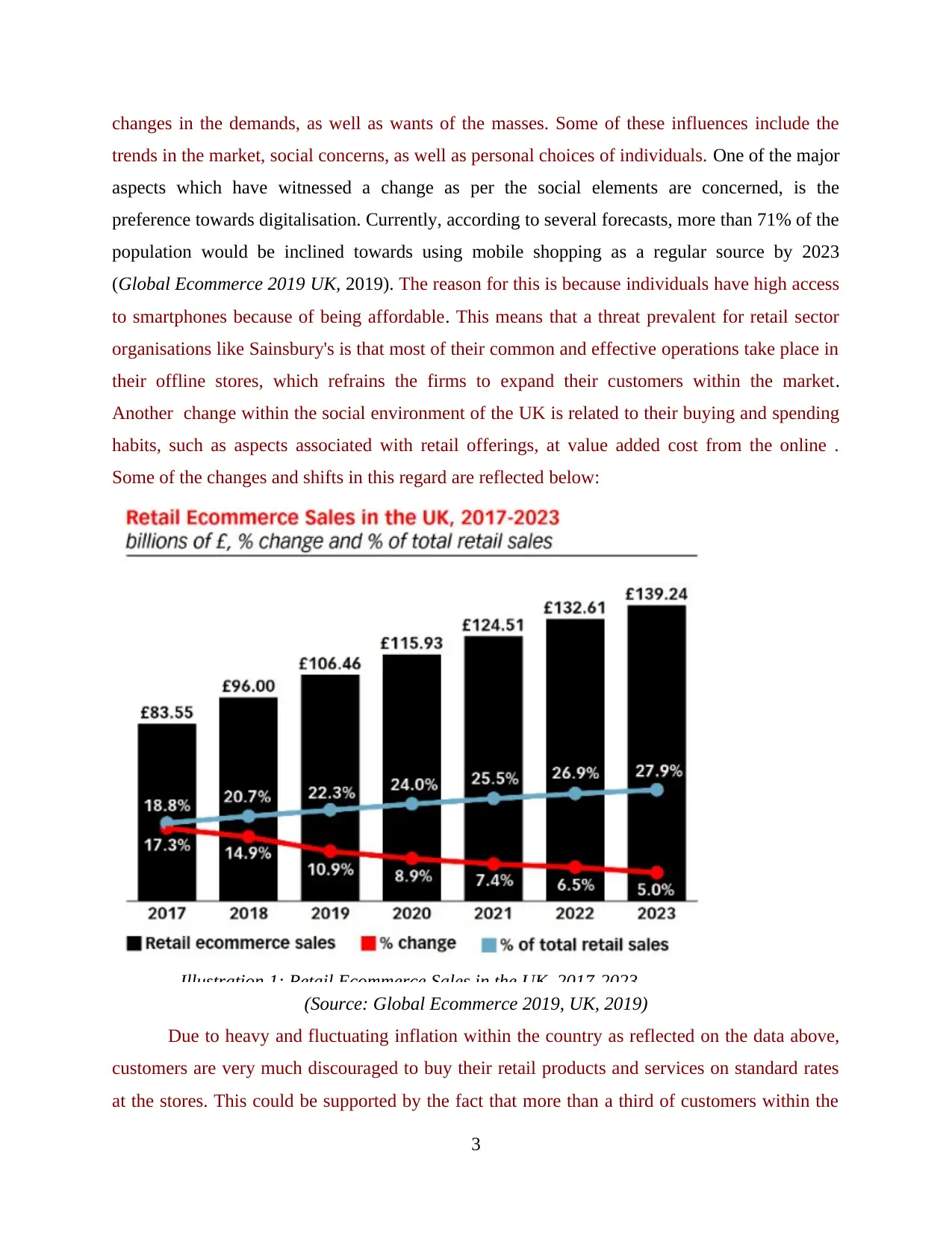
changes in the demands, as well as wants of the masses. Some of these influences include the
trends in the market, social concerns, as well as personal choices of individuals. One of the major
aspects which have witnessed a change as per the social elements are concerned, is the
preference towards digitalisation. Currently, according to several forecasts, more than 71% of the
population would be inclined towards using mobile shopping as a regular source by 2023
(Global Ecommerce 2019 UK, 2019). The reason for this is because individuals have high access
to smartphones because of being affordable. This means that a threat prevalent for retail sector
organisations like Sainsbury's is that most of their common and effective operations take place in
their offline stores, which refrains the firms to expand their customers within the market.
Another change within the social environment of the UK is related to their buying and spending
habits, such as aspects associated with retail offerings, at value added cost from the online .
Some of the changes and shifts in this regard are reflected below:
Illustration 1: Retail Ecommerce Sales in the UK, 2017-2023
(Source: Global Ecommerce 2019, UK, 2019)
Due to heavy and fluctuating inflation within the country as reflected on the data above,
customers are very much discouraged to buy their retail products and services on standard rates
at the stores. This could be supported by the fact that more than a third of customers within the
3
trends in the market, social concerns, as well as personal choices of individuals. One of the major
aspects which have witnessed a change as per the social elements are concerned, is the
preference towards digitalisation. Currently, according to several forecasts, more than 71% of the
population would be inclined towards using mobile shopping as a regular source by 2023
(Global Ecommerce 2019 UK, 2019). The reason for this is because individuals have high access
to smartphones because of being affordable. This means that a threat prevalent for retail sector
organisations like Sainsbury's is that most of their common and effective operations take place in
their offline stores, which refrains the firms to expand their customers within the market.
Another change within the social environment of the UK is related to their buying and spending
habits, such as aspects associated with retail offerings, at value added cost from the online .
Some of the changes and shifts in this regard are reflected below:
Illustration 1: Retail Ecommerce Sales in the UK, 2017-2023
(Source: Global Ecommerce 2019, UK, 2019)
Due to heavy and fluctuating inflation within the country as reflected on the data above,
customers are very much discouraged to buy their retail products and services on standard rates
at the stores. This could be supported by the fact that more than a third of customers within the
3
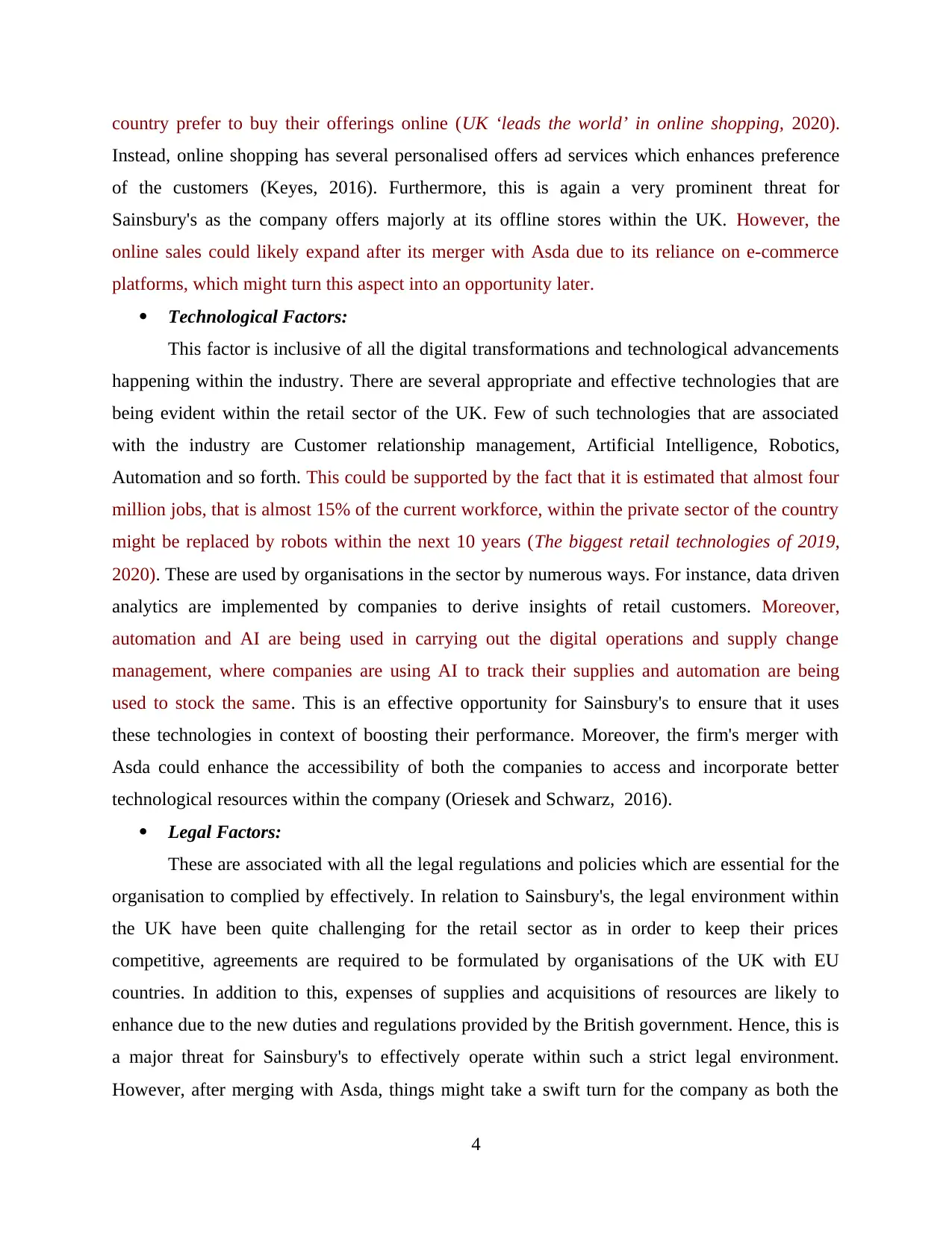
country prefer to buy their offerings online (UK ‘leads the world’ in online shopping, 2020).
Instead, online shopping has several personalised offers ad services which enhances preference
of the customers (Keyes, 2016). Furthermore, this is again a very prominent threat for
Sainsbury's as the company offers majorly at its offline stores within the UK. However, the
online sales could likely expand after its merger with Asda due to its reliance on e-commerce
platforms, which might turn this aspect into an opportunity later.
Technological Factors:
This factor is inclusive of all the digital transformations and technological advancements
happening within the industry. There are several appropriate and effective technologies that are
being evident within the retail sector of the UK. Few of such technologies that are associated
with the industry are Customer relationship management, Artificial Intelligence, Robotics,
Automation and so forth. This could be supported by the fact that it is estimated that almost four
million jobs, that is almost 15% of the current workforce, within the private sector of the country
might be replaced by robots within the next 10 years (The biggest retail technologies of 2019,
2020). These are used by organisations in the sector by numerous ways. For instance, data driven
analytics are implemented by companies to derive insights of retail customers. Moreover,
automation and AI are being used in carrying out the digital operations and supply change
management, where companies are using AI to track their supplies and automation are being
used to stock the same. This is an effective opportunity for Sainsbury's to ensure that it uses
these technologies in context of boosting their performance. Moreover, the firm's merger with
Asda could enhance the accessibility of both the companies to access and incorporate better
technological resources within the company (Oriesek and Schwarz, 2016).
Legal Factors:
These are associated with all the legal regulations and policies which are essential for the
organisation to complied by effectively. In relation to Sainsbury's, the legal environment within
the UK have been quite challenging for the retail sector as in order to keep their prices
competitive, agreements are required to be formulated by organisations of the UK with EU
countries. In addition to this, expenses of supplies and acquisitions of resources are likely to
enhance due to the new duties and regulations provided by the British government. Hence, this is
a major threat for Sainsbury's to effectively operate within such a strict legal environment.
However, after merging with Asda, things might take a swift turn for the company as both the
4
Instead, online shopping has several personalised offers ad services which enhances preference
of the customers (Keyes, 2016). Furthermore, this is again a very prominent threat for
Sainsbury's as the company offers majorly at its offline stores within the UK. However, the
online sales could likely expand after its merger with Asda due to its reliance on e-commerce
platforms, which might turn this aspect into an opportunity later.
Technological Factors:
This factor is inclusive of all the digital transformations and technological advancements
happening within the industry. There are several appropriate and effective technologies that are
being evident within the retail sector of the UK. Few of such technologies that are associated
with the industry are Customer relationship management, Artificial Intelligence, Robotics,
Automation and so forth. This could be supported by the fact that it is estimated that almost four
million jobs, that is almost 15% of the current workforce, within the private sector of the country
might be replaced by robots within the next 10 years (The biggest retail technologies of 2019,
2020). These are used by organisations in the sector by numerous ways. For instance, data driven
analytics are implemented by companies to derive insights of retail customers. Moreover,
automation and AI are being used in carrying out the digital operations and supply change
management, where companies are using AI to track their supplies and automation are being
used to stock the same. This is an effective opportunity for Sainsbury's to ensure that it uses
these technologies in context of boosting their performance. Moreover, the firm's merger with
Asda could enhance the accessibility of both the companies to access and incorporate better
technological resources within the company (Oriesek and Schwarz, 2016).
Legal Factors:
These are associated with all the legal regulations and policies which are essential for the
organisation to complied by effectively. In relation to Sainsbury's, the legal environment within
the UK have been quite challenging for the retail sector as in order to keep their prices
competitive, agreements are required to be formulated by organisations of the UK with EU
countries. In addition to this, expenses of supplies and acquisitions of resources are likely to
enhance due to the new duties and regulations provided by the British government. Hence, this is
a major threat for Sainsbury's to effectively operate within such a strict legal environment.
However, after merging with Asda, things might take a swift turn for the company as both the
4
⊘ This is a preview!⊘
Do you want full access?
Subscribe today to unlock all pages.

Trusted by 1+ million students worldwide
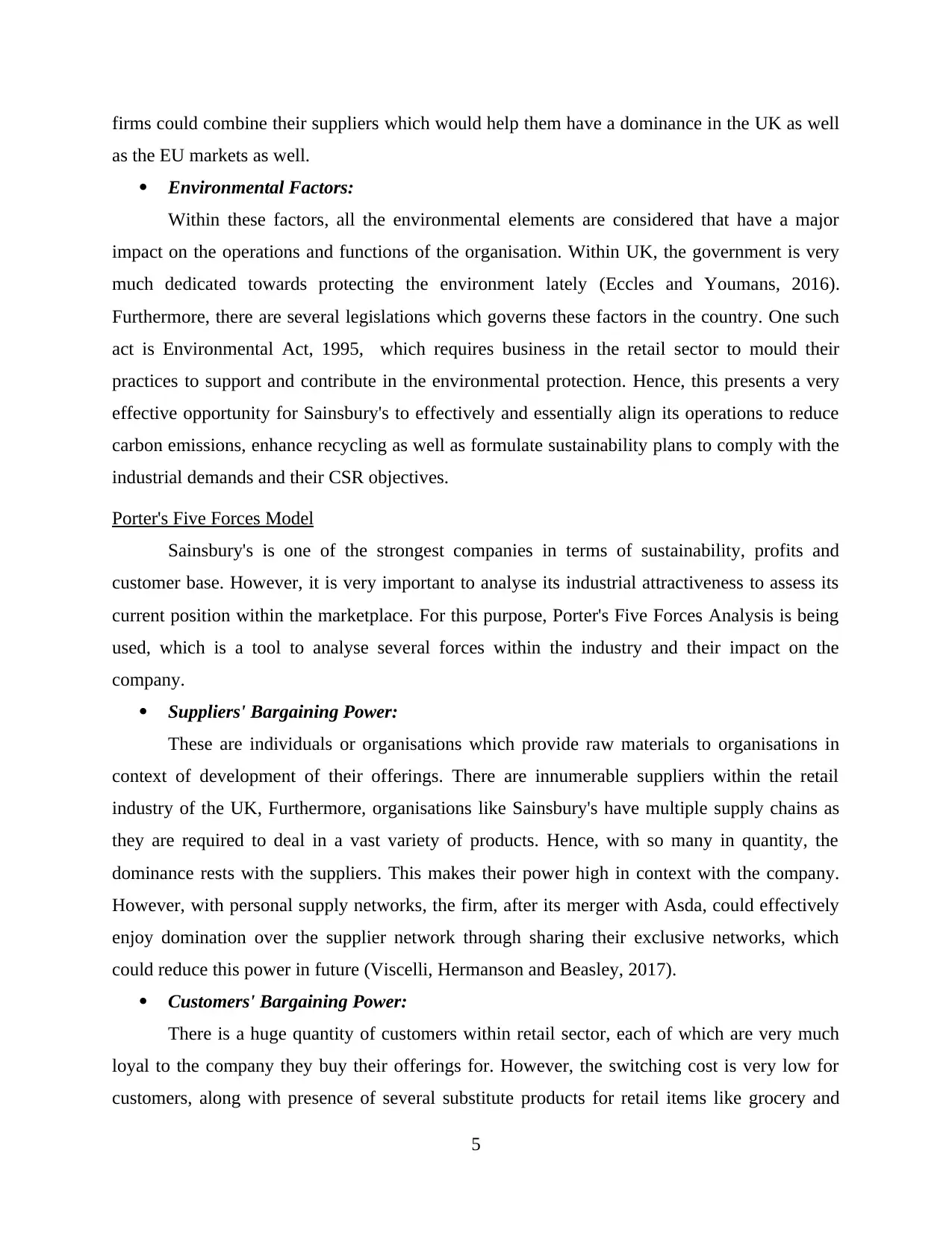
firms could combine their suppliers which would help them have a dominance in the UK as well
as the EU markets as well.
Environmental Factors:
Within these factors, all the environmental elements are considered that have a major
impact on the operations and functions of the organisation. Within UK, the government is very
much dedicated towards protecting the environment lately (Eccles and Youmans, 2016).
Furthermore, there are several legislations which governs these factors in the country. One such
act is Environmental Act, 1995, which requires business in the retail sector to mould their
practices to support and contribute in the environmental protection. Hence, this presents a very
effective opportunity for Sainsbury's to effectively and essentially align its operations to reduce
carbon emissions, enhance recycling as well as formulate sustainability plans to comply with the
industrial demands and their CSR objectives.
Porter's Five Forces Model
Sainsbury's is one of the strongest companies in terms of sustainability, profits and
customer base. However, it is very important to analyse its industrial attractiveness to assess its
current position within the marketplace. For this purpose, Porter's Five Forces Analysis is being
used, which is a tool to analyse several forces within the industry and their impact on the
company.
Suppliers' Bargaining Power:
These are individuals or organisations which provide raw materials to organisations in
context of development of their offerings. There are innumerable suppliers within the retail
industry of the UK, Furthermore, organisations like Sainsbury's have multiple supply chains as
they are required to deal in a vast variety of products. Hence, with so many in quantity, the
dominance rests with the suppliers. This makes their power high in context with the company.
However, with personal supply networks, the firm, after its merger with Asda, could effectively
enjoy domination over the supplier network through sharing their exclusive networks, which
could reduce this power in future (Viscelli, Hermanson and Beasley, 2017).
Customers' Bargaining Power:
There is a huge quantity of customers within retail sector, each of which are very much
loyal to the company they buy their offerings for. However, the switching cost is very low for
customers, along with presence of several substitute products for retail items like grocery and
5
as the EU markets as well.
Environmental Factors:
Within these factors, all the environmental elements are considered that have a major
impact on the operations and functions of the organisation. Within UK, the government is very
much dedicated towards protecting the environment lately (Eccles and Youmans, 2016).
Furthermore, there are several legislations which governs these factors in the country. One such
act is Environmental Act, 1995, which requires business in the retail sector to mould their
practices to support and contribute in the environmental protection. Hence, this presents a very
effective opportunity for Sainsbury's to effectively and essentially align its operations to reduce
carbon emissions, enhance recycling as well as formulate sustainability plans to comply with the
industrial demands and their CSR objectives.
Porter's Five Forces Model
Sainsbury's is one of the strongest companies in terms of sustainability, profits and
customer base. However, it is very important to analyse its industrial attractiveness to assess its
current position within the marketplace. For this purpose, Porter's Five Forces Analysis is being
used, which is a tool to analyse several forces within the industry and their impact on the
company.
Suppliers' Bargaining Power:
These are individuals or organisations which provide raw materials to organisations in
context of development of their offerings. There are innumerable suppliers within the retail
industry of the UK, Furthermore, organisations like Sainsbury's have multiple supply chains as
they are required to deal in a vast variety of products. Hence, with so many in quantity, the
dominance rests with the suppliers. This makes their power high in context with the company.
However, with personal supply networks, the firm, after its merger with Asda, could effectively
enjoy domination over the supplier network through sharing their exclusive networks, which
could reduce this power in future (Viscelli, Hermanson and Beasley, 2017).
Customers' Bargaining Power:
There is a huge quantity of customers within retail sector, each of which are very much
loyal to the company they buy their offerings for. However, the switching cost is very low for
customers, along with presence of several substitute products for retail items like grocery and
5
Paraphrase This Document
Need a fresh take? Get an instant paraphrase of this document with our AI Paraphraser
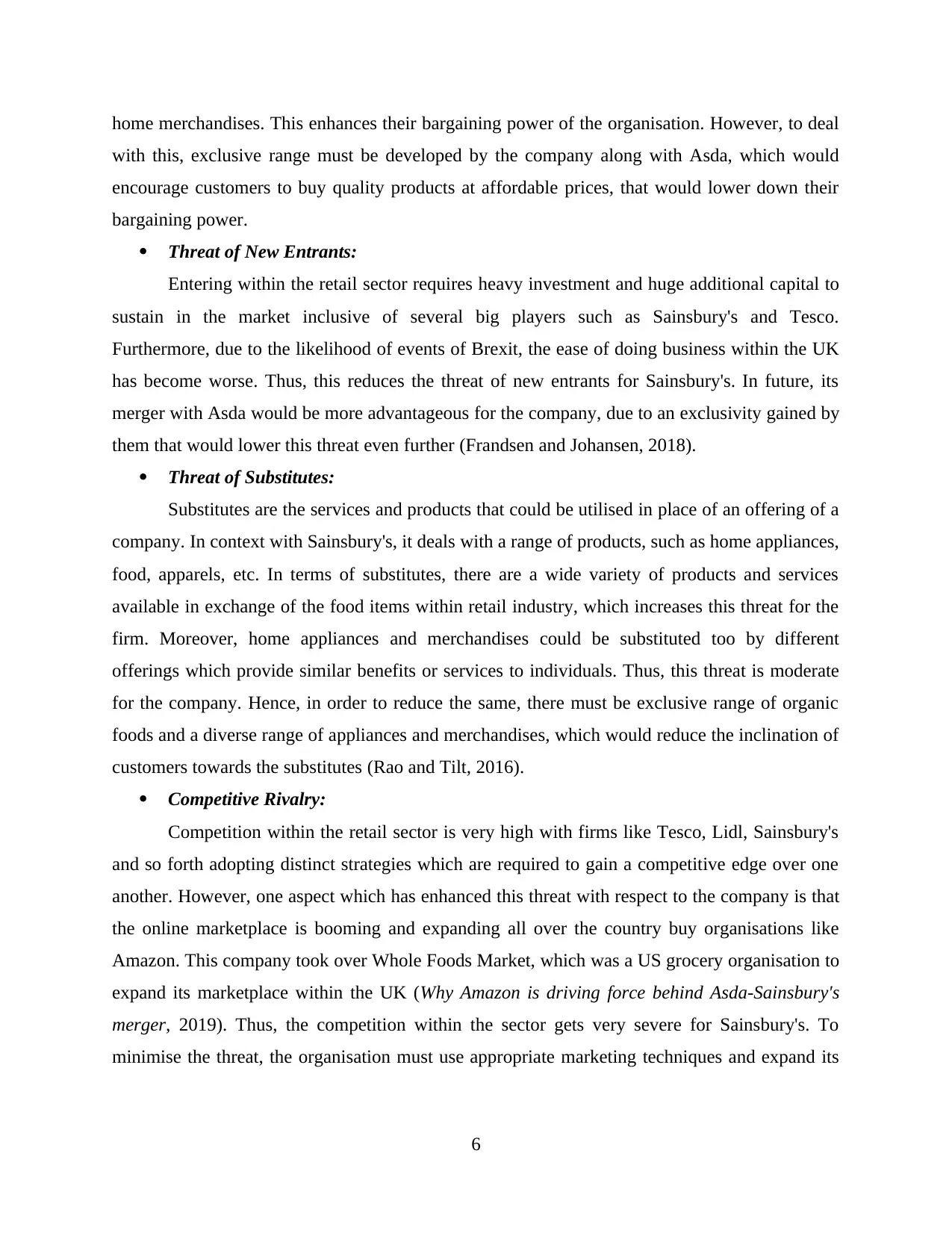
home merchandises. This enhances their bargaining power of the organisation. However, to deal
with this, exclusive range must be developed by the company along with Asda, which would
encourage customers to buy quality products at affordable prices, that would lower down their
bargaining power.
Threat of New Entrants:
Entering within the retail sector requires heavy investment and huge additional capital to
sustain in the market inclusive of several big players such as Sainsbury's and Tesco.
Furthermore, due to the likelihood of events of Brexit, the ease of doing business within the UK
has become worse. Thus, this reduces the threat of new entrants for Sainsbury's. In future, its
merger with Asda would be more advantageous for the company, due to an exclusivity gained by
them that would lower this threat even further (Frandsen and Johansen, 2018).
Threat of Substitutes:
Substitutes are the services and products that could be utilised in place of an offering of a
company. In context with Sainsbury's, it deals with a range of products, such as home appliances,
food, apparels, etc. In terms of substitutes, there are a wide variety of products and services
available in exchange of the food items within retail industry, which increases this threat for the
firm. Moreover, home appliances and merchandises could be substituted too by different
offerings which provide similar benefits or services to individuals. Thus, this threat is moderate
for the company. Hence, in order to reduce the same, there must be exclusive range of organic
foods and a diverse range of appliances and merchandises, which would reduce the inclination of
customers towards the substitutes (Rao and Tilt, 2016).
Competitive Rivalry:
Competition within the retail sector is very high with firms like Tesco, Lidl, Sainsbury's
and so forth adopting distinct strategies which are required to gain a competitive edge over one
another. However, one aspect which has enhanced this threat with respect to the company is that
the online marketplace is booming and expanding all over the country buy organisations like
Amazon. This company took over Whole Foods Market, which was a US grocery organisation to
expand its marketplace within the UK (Why Amazon is driving force behind Asda-Sainsbury's
merger, 2019). Thus, the competition within the sector gets very severe for Sainsbury's. To
minimise the threat, the organisation must use appropriate marketing techniques and expand its
6
with this, exclusive range must be developed by the company along with Asda, which would
encourage customers to buy quality products at affordable prices, that would lower down their
bargaining power.
Threat of New Entrants:
Entering within the retail sector requires heavy investment and huge additional capital to
sustain in the market inclusive of several big players such as Sainsbury's and Tesco.
Furthermore, due to the likelihood of events of Brexit, the ease of doing business within the UK
has become worse. Thus, this reduces the threat of new entrants for Sainsbury's. In future, its
merger with Asda would be more advantageous for the company, due to an exclusivity gained by
them that would lower this threat even further (Frandsen and Johansen, 2018).
Threat of Substitutes:
Substitutes are the services and products that could be utilised in place of an offering of a
company. In context with Sainsbury's, it deals with a range of products, such as home appliances,
food, apparels, etc. In terms of substitutes, there are a wide variety of products and services
available in exchange of the food items within retail industry, which increases this threat for the
firm. Moreover, home appliances and merchandises could be substituted too by different
offerings which provide similar benefits or services to individuals. Thus, this threat is moderate
for the company. Hence, in order to reduce the same, there must be exclusive range of organic
foods and a diverse range of appliances and merchandises, which would reduce the inclination of
customers towards the substitutes (Rao and Tilt, 2016).
Competitive Rivalry:
Competition within the retail sector is very high with firms like Tesco, Lidl, Sainsbury's
and so forth adopting distinct strategies which are required to gain a competitive edge over one
another. However, one aspect which has enhanced this threat with respect to the company is that
the online marketplace is booming and expanding all over the country buy organisations like
Amazon. This company took over Whole Foods Market, which was a US grocery organisation to
expand its marketplace within the UK (Why Amazon is driving force behind Asda-Sainsbury's
merger, 2019). Thus, the competition within the sector gets very severe for Sainsbury's. To
minimise the threat, the organisation must use appropriate marketing techniques and expand its
6
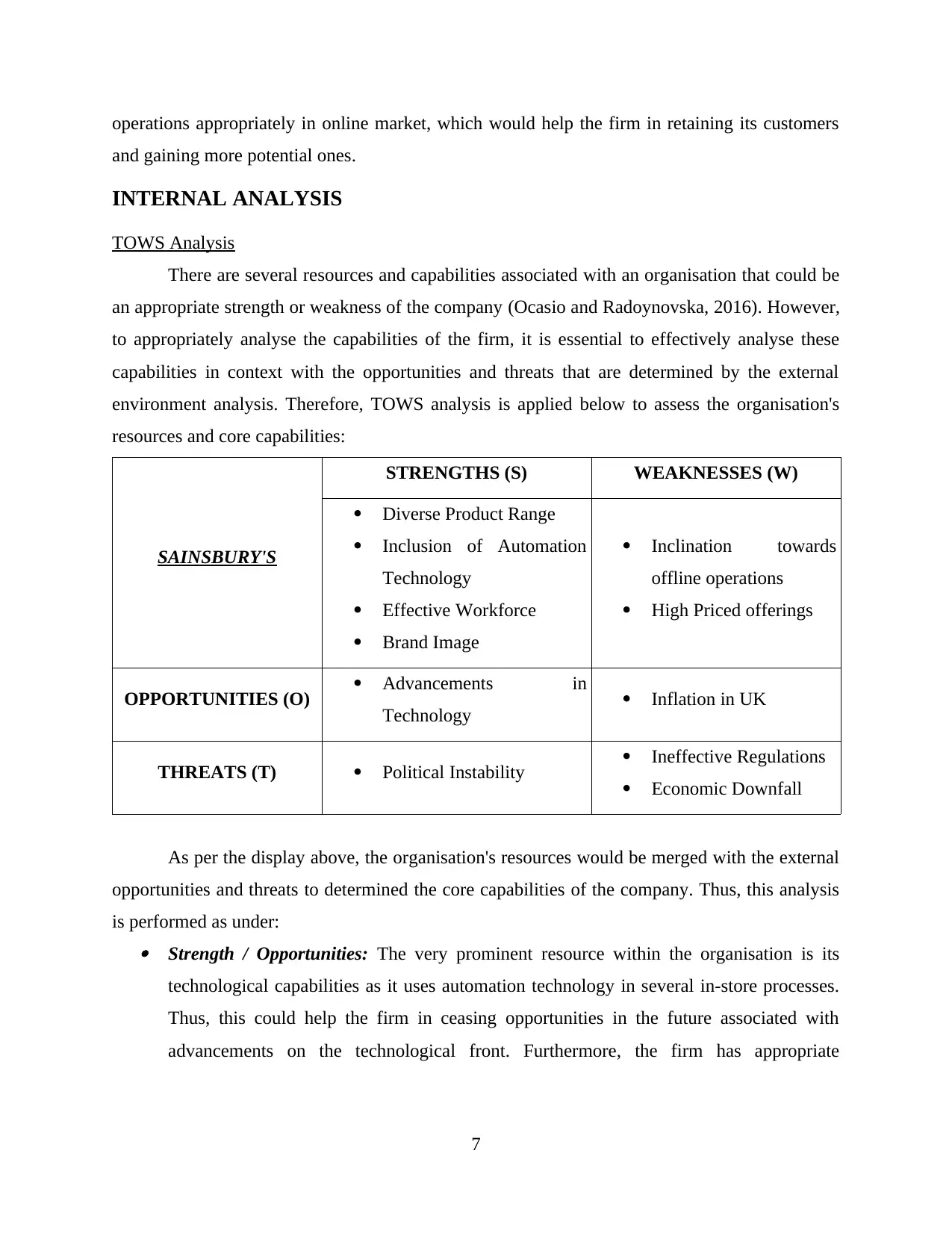
operations appropriately in online market, which would help the firm in retaining its customers
and gaining more potential ones.
INTERNAL ANALYSIS
TOWS Analysis
There are several resources and capabilities associated with an organisation that could be
an appropriate strength or weakness of the company (Ocasio and Radoynovska, 2016). However,
to appropriately analyse the capabilities of the firm, it is essential to effectively analyse these
capabilities in context with the opportunities and threats that are determined by the external
environment analysis. Therefore, TOWS analysis is applied below to assess the organisation's
resources and core capabilities:
SAINSBURY'S
STRENGTHS (S) WEAKNESSES (W)
Diverse Product Range
Inclusion of Automation
Technology
Effective Workforce
Brand Image
Inclination towards
offline operations
High Priced offerings
OPPORTUNITIES (O) Advancements in
Technology Inflation in UK
THREATS (T) Political Instability Ineffective Regulations
Economic Downfall
As per the display above, the organisation's resources would be merged with the external
opportunities and threats to determined the core capabilities of the company. Thus, this analysis
is performed as under: Strength / Opportunities: The very prominent resource within the organisation is its
technological capabilities as it uses automation technology in several in-store processes.
Thus, this could help the firm in ceasing opportunities in the future associated with
advancements on the technological front. Furthermore, the firm has appropriate
7
and gaining more potential ones.
INTERNAL ANALYSIS
TOWS Analysis
There are several resources and capabilities associated with an organisation that could be
an appropriate strength or weakness of the company (Ocasio and Radoynovska, 2016). However,
to appropriately analyse the capabilities of the firm, it is essential to effectively analyse these
capabilities in context with the opportunities and threats that are determined by the external
environment analysis. Therefore, TOWS analysis is applied below to assess the organisation's
resources and core capabilities:
SAINSBURY'S
STRENGTHS (S) WEAKNESSES (W)
Diverse Product Range
Inclusion of Automation
Technology
Effective Workforce
Brand Image
Inclination towards
offline operations
High Priced offerings
OPPORTUNITIES (O) Advancements in
Technology Inflation in UK
THREATS (T) Political Instability Ineffective Regulations
Economic Downfall
As per the display above, the organisation's resources would be merged with the external
opportunities and threats to determined the core capabilities of the company. Thus, this analysis
is performed as under: Strength / Opportunities: The very prominent resource within the organisation is its
technological capabilities as it uses automation technology in several in-store processes.
Thus, this could help the firm in ceasing opportunities in the future associated with
advancements on the technological front. Furthermore, the firm has appropriate
7
⊘ This is a preview!⊘
Do you want full access?
Subscribe today to unlock all pages.

Trusted by 1+ million students worldwide
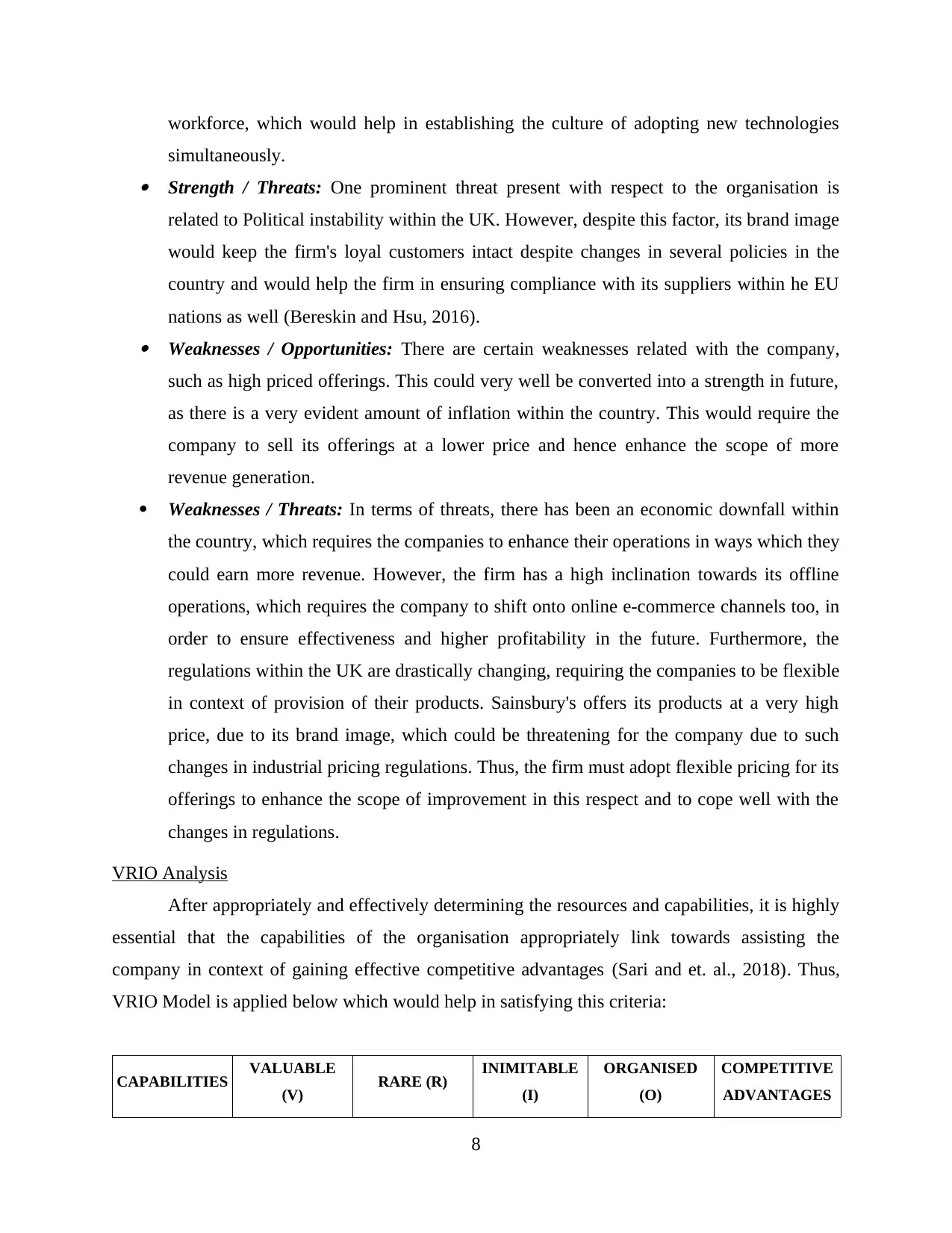
workforce, which would help in establishing the culture of adopting new technologies
simultaneously. Strength / Threats: One prominent threat present with respect to the organisation is
related to Political instability within the UK. However, despite this factor, its brand image
would keep the firm's loyal customers intact despite changes in several policies in the
country and would help the firm in ensuring compliance with its suppliers within he EU
nations as well (Bereskin and Hsu, 2016). Weaknesses / Opportunities: There are certain weaknesses related with the company,
such as high priced offerings. This could very well be converted into a strength in future,
as there is a very evident amount of inflation within the country. This would require the
company to sell its offerings at a lower price and hence enhance the scope of more
revenue generation.
Weaknesses / Threats: In terms of threats, there has been an economic downfall within
the country, which requires the companies to enhance their operations in ways which they
could earn more revenue. However, the firm has a high inclination towards its offline
operations, which requires the company to shift onto online e-commerce channels too, in
order to ensure effectiveness and higher profitability in the future. Furthermore, the
regulations within the UK are drastically changing, requiring the companies to be flexible
in context of provision of their products. Sainsbury's offers its products at a very high
price, due to its brand image, which could be threatening for the company due to such
changes in industrial pricing regulations. Thus, the firm must adopt flexible pricing for its
offerings to enhance the scope of improvement in this respect and to cope well with the
changes in regulations.
VRIO Analysis
After appropriately and effectively determining the resources and capabilities, it is highly
essential that the capabilities of the organisation appropriately link towards assisting the
company in context of gaining effective competitive advantages (Sari and et. al., 2018). Thus,
VRIO Model is applied below which would help in satisfying this criteria:
CAPABILITIES VALUABLE
(V) RARE (R) INIMITABLE
(I)
ORGANISED
(O)
COMPETITIVE
ADVANTAGES
8
simultaneously. Strength / Threats: One prominent threat present with respect to the organisation is
related to Political instability within the UK. However, despite this factor, its brand image
would keep the firm's loyal customers intact despite changes in several policies in the
country and would help the firm in ensuring compliance with its suppliers within he EU
nations as well (Bereskin and Hsu, 2016). Weaknesses / Opportunities: There are certain weaknesses related with the company,
such as high priced offerings. This could very well be converted into a strength in future,
as there is a very evident amount of inflation within the country. This would require the
company to sell its offerings at a lower price and hence enhance the scope of more
revenue generation.
Weaknesses / Threats: In terms of threats, there has been an economic downfall within
the country, which requires the companies to enhance their operations in ways which they
could earn more revenue. However, the firm has a high inclination towards its offline
operations, which requires the company to shift onto online e-commerce channels too, in
order to ensure effectiveness and higher profitability in the future. Furthermore, the
regulations within the UK are drastically changing, requiring the companies to be flexible
in context of provision of their products. Sainsbury's offers its products at a very high
price, due to its brand image, which could be threatening for the company due to such
changes in industrial pricing regulations. Thus, the firm must adopt flexible pricing for its
offerings to enhance the scope of improvement in this respect and to cope well with the
changes in regulations.
VRIO Analysis
After appropriately and effectively determining the resources and capabilities, it is highly
essential that the capabilities of the organisation appropriately link towards assisting the
company in context of gaining effective competitive advantages (Sari and et. al., 2018). Thus,
VRIO Model is applied below which would help in satisfying this criteria:
CAPABILITIES VALUABLE
(V) RARE (R) INIMITABLE
(I)
ORGANISED
(O)
COMPETITIVE
ADVANTAGES
8
Paraphrase This Document
Need a fresh take? Get an instant paraphrase of this document with our AI Paraphraser
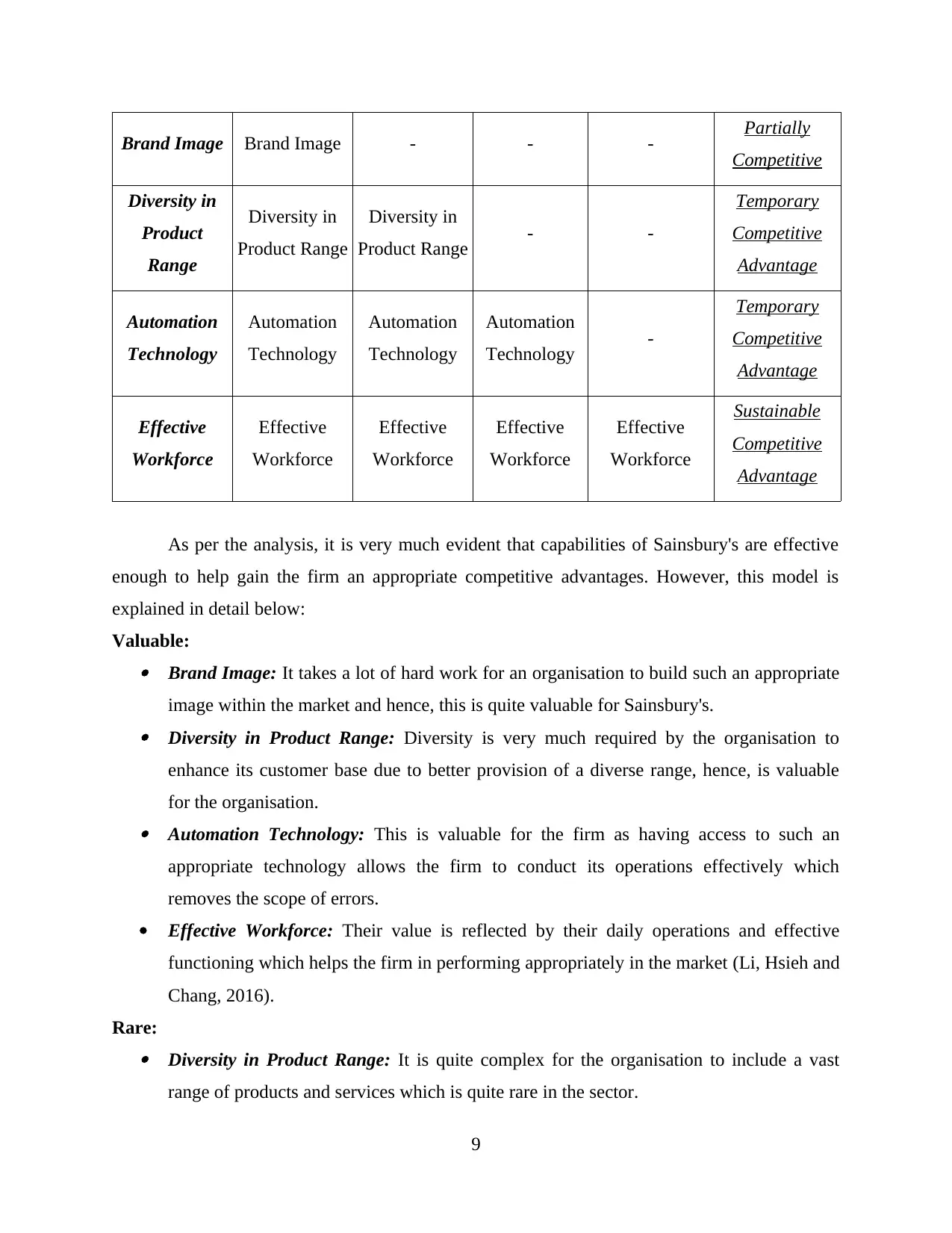
Brand Image Brand Image - - - Partially
Competitive
Diversity in
Product
Range
Diversity in
Product Range
Diversity in
Product Range - -
Temporary
Competitive
Advantage
Automation
Technology
Automation
Technology
Automation
Technology
Automation
Technology -
Temporary
Competitive
Advantage
Effective
Workforce
Effective
Workforce
Effective
Workforce
Effective
Workforce
Effective
Workforce
Sustainable
Competitive
Advantage
As per the analysis, it is very much evident that capabilities of Sainsbury's are effective
enough to help gain the firm an appropriate competitive advantages. However, this model is
explained in detail below:
Valuable: Brand Image: It takes a lot of hard work for an organisation to build such an appropriate
image within the market and hence, this is quite valuable for Sainsbury's. Diversity in Product Range: Diversity is very much required by the organisation to
enhance its customer base due to better provision of a diverse range, hence, is valuable
for the organisation. Automation Technology: This is valuable for the firm as having access to such an
appropriate technology allows the firm to conduct its operations effectively which
removes the scope of errors.
Effective Workforce: Their value is reflected by their daily operations and effective
functioning which helps the firm in performing appropriately in the market (Li, Hsieh and
Chang, 2016).
Rare: Diversity in Product Range: It is quite complex for the organisation to include a vast
range of products and services which is quite rare in the sector.
9
Competitive
Diversity in
Product
Range
Diversity in
Product Range
Diversity in
Product Range - -
Temporary
Competitive
Advantage
Automation
Technology
Automation
Technology
Automation
Technology
Automation
Technology -
Temporary
Competitive
Advantage
Effective
Workforce
Effective
Workforce
Effective
Workforce
Effective
Workforce
Effective
Workforce
Sustainable
Competitive
Advantage
As per the analysis, it is very much evident that capabilities of Sainsbury's are effective
enough to help gain the firm an appropriate competitive advantages. However, this model is
explained in detail below:
Valuable: Brand Image: It takes a lot of hard work for an organisation to build such an appropriate
image within the market and hence, this is quite valuable for Sainsbury's. Diversity in Product Range: Diversity is very much required by the organisation to
enhance its customer base due to better provision of a diverse range, hence, is valuable
for the organisation. Automation Technology: This is valuable for the firm as having access to such an
appropriate technology allows the firm to conduct its operations effectively which
removes the scope of errors.
Effective Workforce: Their value is reflected by their daily operations and effective
functioning which helps the firm in performing appropriately in the market (Li, Hsieh and
Chang, 2016).
Rare: Diversity in Product Range: It is quite complex for the organisation to include a vast
range of products and services which is quite rare in the sector.
9
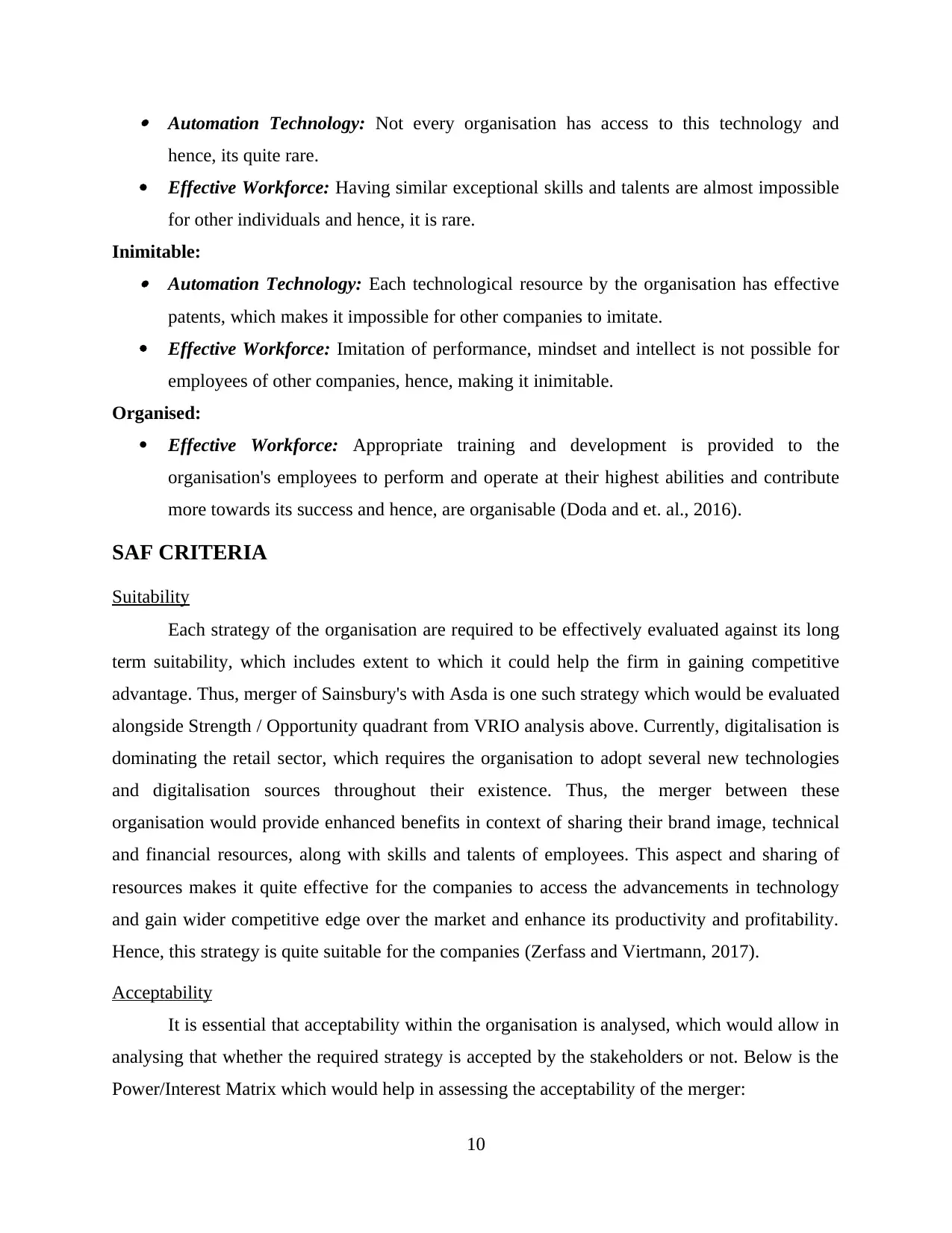
Automation Technology: Not every organisation has access to this technology and
hence, its quite rare.
Effective Workforce: Having similar exceptional skills and talents are almost impossible
for other individuals and hence, it is rare.
Inimitable: Automation Technology: Each technological resource by the organisation has effective
patents, which makes it impossible for other companies to imitate.
Effective Workforce: Imitation of performance, mindset and intellect is not possible for
employees of other companies, hence, making it inimitable.
Organised:
Effective Workforce: Appropriate training and development is provided to the
organisation's employees to perform and operate at their highest abilities and contribute
more towards its success and hence, are organisable (Doda and et. al., 2016).
SAF CRITERIA
Suitability
Each strategy of the organisation are required to be effectively evaluated against its long
term suitability, which includes extent to which it could help the firm in gaining competitive
advantage. Thus, merger of Sainsbury's with Asda is one such strategy which would be evaluated
alongside Strength / Opportunity quadrant from VRIO analysis above. Currently, digitalisation is
dominating the retail sector, which requires the organisation to adopt several new technologies
and digitalisation sources throughout their existence. Thus, the merger between these
organisation would provide enhanced benefits in context of sharing their brand image, technical
and financial resources, along with skills and talents of employees. This aspect and sharing of
resources makes it quite effective for the companies to access the advancements in technology
and gain wider competitive edge over the market and enhance its productivity and profitability.
Hence, this strategy is quite suitable for the companies (Zerfass and Viertmann, 2017).
Acceptability
It is essential that acceptability within the organisation is analysed, which would allow in
analysing that whether the required strategy is accepted by the stakeholders or not. Below is the
Power/Interest Matrix which would help in assessing the acceptability of the merger:
10
hence, its quite rare.
Effective Workforce: Having similar exceptional skills and talents are almost impossible
for other individuals and hence, it is rare.
Inimitable: Automation Technology: Each technological resource by the organisation has effective
patents, which makes it impossible for other companies to imitate.
Effective Workforce: Imitation of performance, mindset and intellect is not possible for
employees of other companies, hence, making it inimitable.
Organised:
Effective Workforce: Appropriate training and development is provided to the
organisation's employees to perform and operate at their highest abilities and contribute
more towards its success and hence, are organisable (Doda and et. al., 2016).
SAF CRITERIA
Suitability
Each strategy of the organisation are required to be effectively evaluated against its long
term suitability, which includes extent to which it could help the firm in gaining competitive
advantage. Thus, merger of Sainsbury's with Asda is one such strategy which would be evaluated
alongside Strength / Opportunity quadrant from VRIO analysis above. Currently, digitalisation is
dominating the retail sector, which requires the organisation to adopt several new technologies
and digitalisation sources throughout their existence. Thus, the merger between these
organisation would provide enhanced benefits in context of sharing their brand image, technical
and financial resources, along with skills and talents of employees. This aspect and sharing of
resources makes it quite effective for the companies to access the advancements in technology
and gain wider competitive edge over the market and enhance its productivity and profitability.
Hence, this strategy is quite suitable for the companies (Zerfass and Viertmann, 2017).
Acceptability
It is essential that acceptability within the organisation is analysed, which would allow in
analysing that whether the required strategy is accepted by the stakeholders or not. Below is the
Power/Interest Matrix which would help in assessing the acceptability of the merger:
10
⊘ This is a preview!⊘
Do you want full access?
Subscribe today to unlock all pages.

Trusted by 1+ million students worldwide
1 out of 16
Related Documents
Your All-in-One AI-Powered Toolkit for Academic Success.
+13062052269
info@desklib.com
Available 24*7 on WhatsApp / Email
![[object Object]](/_next/static/media/star-bottom.7253800d.svg)
Unlock your academic potential
Copyright © 2020–2025 A2Z Services. All Rights Reserved. Developed and managed by ZUCOL.





